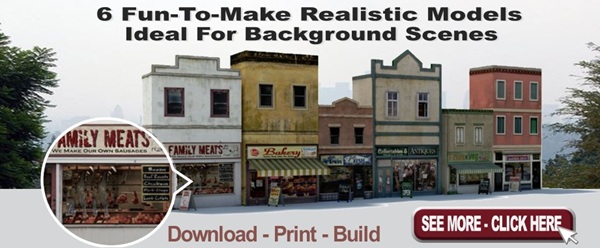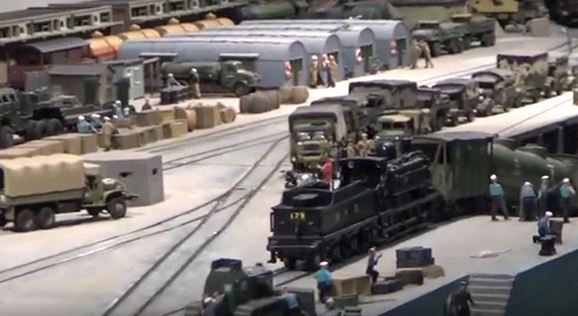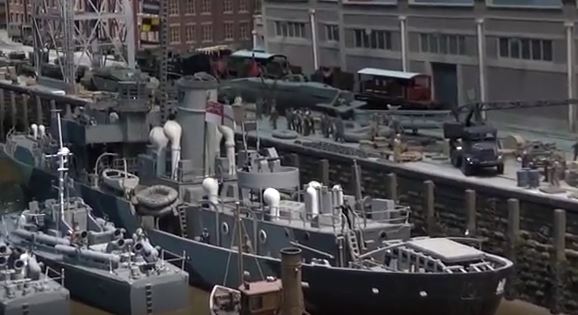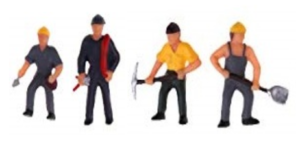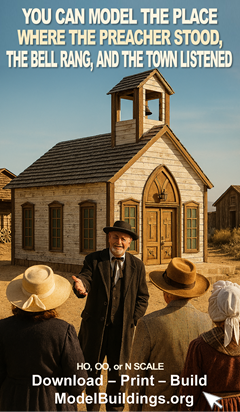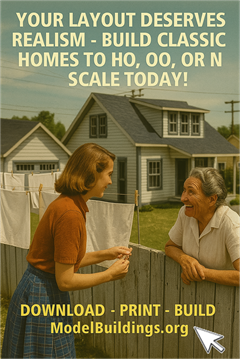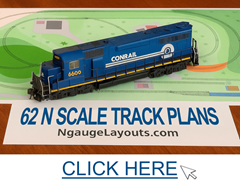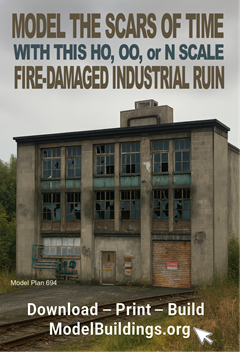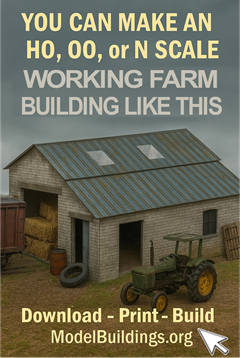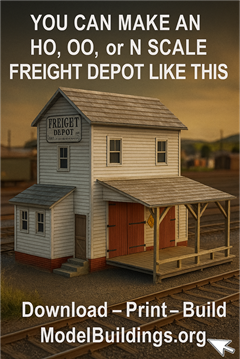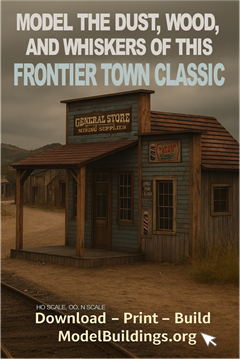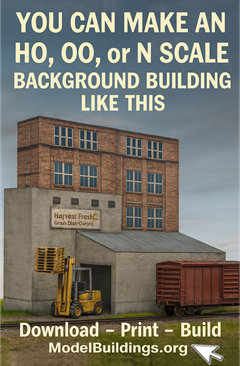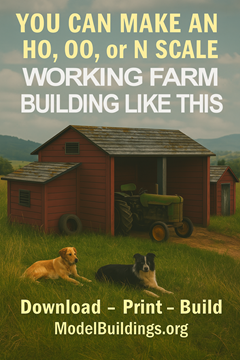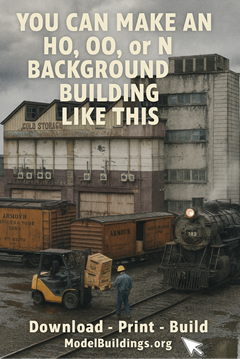Everything on model trains, model railroads, model railways, locomotives, model train layouts, scenery, wiring, DCC and more. Enjoy the world's best hobby... model railroading!
Ways To Remove Flex Track and Ballast
Ben posted this question for readers:
“Is there a way of easily and cleanly removing flex track and ballast? I am thinking of replacing my flex track with regular track that I think will look less fake.”
If you have a question, then have it published on the Blog. See the link below.
Plans for 13 Old West Models Now Available
Now you can create your very own old wild western town with these 13 downloadable plans. Make them to OO gauge, N scale or HO scale. https://www.modelbuildings.org/wildwest-mining/
ModelBuildings.org also has a series of old western mining town structures that would fit well the old west models seen above.
Powering Lighting on Layout
James asks:
“How can I use a 9v or 12v to wall adapter to power some accessories especially lighting? Can I use the wall adapter and cut and splice the ends to led lights ? Or splice it to a block and then run from there to my led lights? A little help anyone please. I’ve heard of people using wall adapters but not how to splice them to leads.”
Add your comment below.
Auto Reversing Trolley Track
Bill sent in this question:
“I’m planning a point to point trolley track on my layout, separate from the mainline that would run a DC Bachmann Brill trolley. I’d like the trolley to reverse direction at each end of the track without my intervention. What would be the easiest way to do this reliably? Thanks in advance.”
Fixing Shorts When Locos Power Up
Michael S asked:
“I have an DC analog HO scale railroad and following some work on the layout track I am now getting a short which stops me from fully powering. I only get to about 40%. Anything above this and it shorts out. I can wind down the power so the loco starts to slowly run. Is this problem something to do with a turn out?”
Lift Out or Up Section For Pass Through
Max wants advice from others and asks:
“My plan was to construct a duck-under to make my way to the inner track walkway. The benchwork is approx. 42 inches above the floor, which sounds ok, but right now I have my foot in cast (I won’t bore you with what happened… and you’ll probably only laugh when you hear my stupidity). It made me think though, I am not getting any younger so I should try and make access as easy as possible for an old codger like me, so a duck-under might not be the best option. I thought of using a rolling stool but that’s not great.
Thinking it through, I probably will need to have a hinged section that I could swing or lift up. It will need to be wide enough so I can easily squeeze my way through and past the benchwork some 4 ft. Without reveal my stomach size I will probably need about 14 inches to get by.
The particular portion of track will have 4 tracks so I will need to work out the electrics and make sure the tracks properly align. Obviously I don’t want to mess things up with constant use upsetting the electrics or track alignment. If someone has done something similar I would be interested in any advise – tips?”
Add your comments below to assist Max. Your question can also be published – see below.
13 Impressive Old West Buildings to Download, Print, and Build for Your Model Railroad
Have you ever wanted to create a realistic miniature old western town either for your model railroad, or as a scenic diorama without trains? Look no further, here are 13 old west buildings that can be made as OO gauge, N scale or HO scale buildings. https://www.modelbuildings.org/wildwest-mining/
The site also has a range of old west mining town buildings that would go with the nicely with the above series.
War-Time Peterborough Arena Model Rail Show
Ron from Leicester north of London in the UK sent in these photos taken at a Peterborough Arena Model Rail Show. He apologizes that a couple of them are a little blurry, but I thought they were so interesting, they deserved to be published regardless.
These photos are a wonderful example of a model train display telling a story. As many experienced hobbyists know; it is always a good start to write a short story (or series of notes) about the scene or industry you intend to create, or to thoroughly research aspects of a real railroad if you intend to model it. Using the ‘prototypical’ approach is to take a real full-sized railroad and model its operation at a certain point during a certain period in time.
Obviously is is easy to take the detailing to extremes, but often it is the attention to detail that adds the real interest and realism to a railroad display. Replicating a real life scene requires the location to be constructed so as to closely resemble the real community and surroundings as accurately as possible, if that is the way you decide to go. Others in the hobby just like to do their own thing and create a scene from their own imagination, and that’s okay too. The important aspect of this wonderful hobby is to enjoy what you are doing, and create something that you personally want to create, regardless of whether you want to create a prototypical replica, or something created from your imagination.
Feel free to add a comment below.
Changing from 18″ to 22″ Curves With Original Turnouts
Seb submitted this question for readers to ponder:
“I have an HO diesel loco with 6 (3,3) trucks. A couple of months back I converted the track from 18″ to 22″ curves and I decided to leave the original turnouts intact. This might be the cause of the derailments when the unit crosses the turnouts…not sure?!? I don’t want to replace things if I am barking up the wrong tree? Should I substitute the turnouts with #6’s [22″ curves] to minimize derailments?”
Get your question published. See link below.
Adhesives For Sticking Down Plastic Model People and Animals – The Dilemma
“I’ve heard Elmer’s white glue is good for laying down the track with ballast. Problem is it takes some time to properly set hard if using it for other purposes. For gluing plastic model figurines in place it’s hopeless. They inevitably fall over. Does one of your members know of a hobby adhesive that will dry and set hard quickly and one that is useful for sticking plastic model figures to the ground?”
Have your question published. See below.
Nailing EZ Track to Plywood
Mike sent in this question. Perhaps you can help:
“I want to nail down to plywood my EZ track. I have some Atlas track nails which are long enough. Some of the track pieces need to be drilled in order for the nails to work. Do I use a pin vise or a mini drill? How do I determine the drill bit size I need? The hole is the size of the Atlas track nails. Thanks”
Access To Train Wheels
 Robin sent in this question for readers:
Robin sent in this question for readers:
“My Roco diesel engine (HO scale) requires traction tires part 40069 which I see I can get on eBay. Problem is; I can’t figure how to fit the tires. I can’t see any screws to undo thereby exposing the wheels? I know some other engines have tiny screws to undo to access the wheels. Any suggestions?”
Have your question published here. Use link under this post.
Track On Cork Difficulties
Ron W posted this question to challenge readers:
“This might sound like a stupid question but I want to lay cork using the center of the track. Marking the line with the track in position on plywood is difficult. I need some kind of tool to mark the center line accurately because my eyesight is not good enough. I thought of using a pencil through the hole but this didn’t work. I concluded the marking pencil needs to be securely mounted to the truck hole. Is there a better way of doing this or even a suitable tool available?”
Have your question posted on this Blog for others in the hobby to see and comment on. Use the link below.
Model Train Passes Funeral Gathering
There’s an old rule in this hobby to add people and animals to model railroad scenery to bring the scene to life, but this is an interesting twist to that concept. This grave-side funeral gathering was spotted by Walter at the Balatonfüred International Model-Railway Exhibition, Hungary. It certainly adds interest to scene and is something a little different from what you are likely to see on most layouts.
Hornby 08 Shunter With Sound Problem
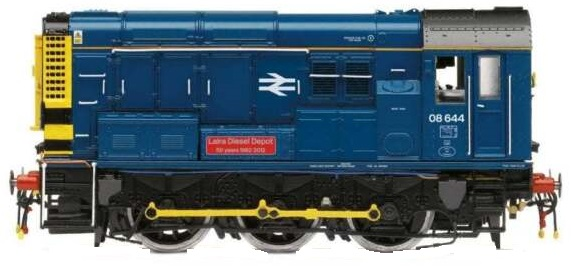 Rick S used the ASK A QUESTION form to submit this question:
Rick S used the ASK A QUESTION form to submit this question:
“I model British Rail in OO gauge and have a Hornby 08 Shunter that is giving me problems. When I operate it with the sound switched on it stops and starts back up then just repeats itself over. When I run it minus the sound it works fine. What can I do please?”
Post your question on the Blog using the link below.
Electrical Switch Relay For LED
Peter M asks readers:
I would like to run LED street lights off of my garden railway track. As LED’s only work in one direction can any one tell me what I need in the way of an electrical switch (relay) to enable the lights to work when I change direction?
Post your answer below.
